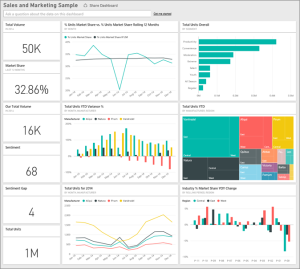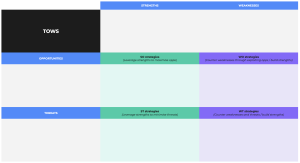When it comes to maximising your marketing impact, don’t settle for only updating old spreadsheets or merely tweaking your previous year’s digital marketing plan. With the continuous growth of digital adoption and online commerce, getting your strategy right is essential to stand out from the competition and capture customers at different stages of the funnel.

[SOURCE: WE ARE SOCIAL & MELTWATER]
Taking your marketing strategy to the next level requires understanding key principles and techniques that can increase ROI and help you reach success. This comprehensive guide offers advanced tips, tools, and strategies for developing an effective marketing plan to elevate your business to new heights.
Understand where you are now.
The first step to creating an effective digital marketing plan is to understand what you are currently doing and how your internal strengths and weaknesses (and external factors such as the macro-environment and the competitive landscape) will influence the outcome of your goals and objectives.
Action points:
- Start by identifying what you need to ask, what you know, and what you don’t to establish how much revenue your marketing activities contributed within the last year and the ROI of your marketing initiatives
- Audit all your digital marketing activities across different channels and platforms
- Consider which data you need to collect
- Collect Accurate Data – determine which channel sources/time frames you will use
- Implement statistical models on quantitative data to measure and evaluate the performance and potential of marketing programs. For example, you can understand central tendencies and variability using the following:
- Measures for central tendency (Mean, Mode, Medium)
- Measures for variability (Min & max range, Variance and standard deviation, Skewness, Kurtosis)
- Find patterns in your qualitative or unstructured data and categorise them by creating themes that paint a clearer picture of trends and user behaviour
- Use data findings to report how well your marketing campaigns are performing, monitor current trends and predict future trends, and decide the future course of action
- Update your competitor analysis to better understand their strengths and where your competitors are investing their efforts:
- Identify who to benchmark to
- Define what key factors you will use for benchmarking
- Collect relevant data and compare it with your processes
- Assess competitors’ data to determine what they are trying to achieve, their target market, strategic focus, marketing mix, and marketing capabilities to identify what you can learn from their successful and unsuccessful activities
- Carry out a detailed micro and macro environment analysis
Tip: Integrate what you learned from your data analysis and the previous models with this step
Define your marketing goals and the strategies that will work best for you.
Now that you know where you are, it’s time to determine where you want to be and clearly define the objectives and goals that you want to achieve. Doing so will create a framework for your marketing activities and provide valuable metrics for measuring success.
Knowing which strategies will be most effective for your business is the key to realising your marketing objectives. Remember, whatever methods you choose should be targeted, measurable, cost-effective, and produce impactful results. Once you have identified the best strategy for your business, you can start planning how best to implement them.
Action Points:
- Align with your company’s goals, understand how much marketing should contribute directly to revenue and how to prioritise acquisition, retention, and expansion
- Establish the main objective that you are trying to achieve with your marketing activities
- Determine how you will measure the success of your marketing initiatives with clear, realistic goals that can be measured and are relevant to your business objectives
Tip: Use insights from your data analysis to set objectives and KPIs based on your historical success the marketing performance at different stages of the funnel
- Define 3-4 specific strategies per goal to solidify the process with defined guidelines and actions that will contribute to achieving your objectives
- Break down each strategy into projects with tactics and timely activities that can be actioned and measured.
Tip: Keep the proven channels that contribute to ROI and positively impact meaningful KPIs. Allocate resources for reviewing low-performing channels and new initiatives: formulate hypotheses and create a testing framework
- Add metrics to track your performance and determine if your plan achieves the desired results.
Tip: Tie strategies and channels to specific KPIs to measure their direct impact on your goals
Put your plan into action and execute your marketing tactics.
A good strategy is nothing without timely execution. So it’s time to unfold your goals and strategies and break your projects into smaller actionable tasks. Clearly defined responsibilities and a well-thought schedule will enable you to execute your plan, keep you on track and accomplish each project on time.
Action Points:
-
- Document and execute your plan for the next 12 months
Tip: Create a timeline or a Gantt chart and add delivery dates, collaborators, responsibilities, structures, resources, and skills needed to implement each strategy
- Keep a record of what you will do and how it is performing.
Tip: Create global documents for the wider team (buyer persona, competitor research, global calendar, metrics dashboard), and team-specific documents (editorial calendar, social media calendar, distribution checklist, advertisement investment plan, advertisement results tracker, traffic results dashboard, conversions and results dashboards)
- Make your plan fully operational by breaking it into smaller chunks.
- Document and execute your plan for the next 12 months
Tip: Build a 30-60-90 day plan to start actioning your strategy
Use measurement and optimisation to improve results continuously.
Once you have implemented your marketing strategies, don’t stop there! It is essential to monitor your progress and outcomes regularly and make adjustments to your plan as needed to ensure you are constantly achieving the best possible results.
Use data to track customer behaviour and make informed decisions on adjusting or refining your strategy by testing different tactics or channels. Doing so will help you accurately monitor the success of your digital marketing activities so that they can reach their full potential in obtaining maximum ROI.
Action Points:
- Make sure that you are implementing the best attribution and conversion tracking practices with methods like enhanced conversions, or conversions API
- Customise your Google Analytics goals, events, dimensions, and segments to track the data that is relevant to your objectives
- Define where and how you will show the results of marketing.
Tip: Consider implementing a digital performance review platform like Data Studio or Power BI to visualise dashboards and stay on top of your live data
- Use models like multi-touch attribution to understand the value that each touchpoint or channel has on driving a conversion
- Stay close to the data and analyse it regularly to understand your marketing strategy deeply. This allows you to identify opportunities for improvement and make accurate predictions of how your marketing initiatives will impact business outcomes.

[SOURCE: MICROSOFT]
Conclusion & takeaways.
- Look at your previous year’s results and establish what contributed to the company’s performance
- Understand the effects of the micro and macro environment on your strategy
- Identify the company’s goals for the new financial year and break them into marketing objectives, strategies, and projects that you can measure with KPIs that correlate with the bigger goals
- Create an action plan that can be followed easily and tracks progress
- Document your marketing plan, execute it using timelines, and create dashboards to know performance and adjust accordingly

February 16, 2023

